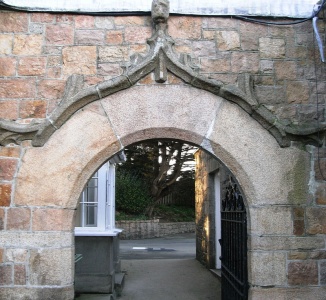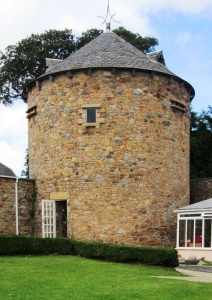La Hague Manor
La Hague Manor, the most important in the parish of St Peter, took its name from its first owners, the de la Hagues, who probably came from the Cap de la Hague area in the far north of the Cotentin Peninsular of Normandy. This was probably as early as the 13th century, because the family is known to have absorbed the neighbouring fiefs of Niemes, Nobretz and des Blancs Esperons by 1309. The fief was mentioned in the Extente of 1274, and in 1331 it was held by Pierre de la Hague.

Rebuilding
This is not to say that the manor house as it stands today can be traced back that far. Francois de Carteret built the colombier in 1629 and rebuilt the house in 1634. Thomas Le Breton rebuilt it again in 1753 and Colonel C P Le Cornu made extensive alterations in 1871.
So the property can be seen to have passed through the hands of some of the island's most prominent families. During the German Occupation it became infantry barracks and the lawn was covered with wooden huts containing ammunition. Strangely for a property of this antiquity, no datestones are recorded in the Jersey Datestone Register.
The diaries of Benjamin La Cloche record:
- "Mr francois de Carteret bastit sa Maison de la Hague Lan 1634 et son colombier et garende audit lieu quelque Cinq our Six ans au paravant. (Mr Francois de Carteret built his house at La Hague in the year 1634 and his dovecot and warren there some five or six years before)."
It is possible, however, that Francois de Carteret did not demolish the old manor house, but built a second one on a different site, because an old family document of 1643 refers to la neuve et la vieille maison de la Hague. Francois was the son of Helier de Carteret and Sarah Dumaresq, and the dovecote has an armorial plaque with the de Carteret and Dumaresq arms, although this is a much later addition.
The word garende, meaning a warren, could be spelt in a wide variety of ways and was an area in which it was forbidden to hunt or shoot without the permission of the seigneur. A warren could hardly be built, but Francois de Carteret probably enclosed the area. Joan Stevens, in her Old Jersey Houses, says that there was probably already a colombier present as well as the earlier house.
The seigneur had a number of obligations. He was obliged to keep a prison, perhaps because his manor was some distance from the island's main prison, which was then at Mont Orgueil Castle. As Seigneur of des Blancs Esperons he was obliged to present the King with a pair of silver spurs every year.
The seigneurial mill, La Hague Mill in St Peter's Valley, was previously called Moulin Tostain, after an 11th century priest of that name.
Families
By 1489 the four fiefs had passed by marriage to the Mallet family, who sold them in 1602 to a junior branch of the de Carterets of St Ouen. The estate would eventually pass into the Le Breton (1747), Pipon and Le Cornu (1871) families.
In 1901 the property was owned by Colonel Charles Philip Le Cornu (1829-1911) ADC to King Edward VII at the time. He lived there with his wife Ann, nee Helleur (1839- ) and their daughters Annie (1860- ) and Emily (1862- ). They had a cook, a parlour maid and a kitchen maid.
St George's School
Since 1979 the manor has been the home of St George's School.
History from school website
Little is known of the origins of the manor but the original fief, (an estate of land granted by the crown) may have been in existence as early as 1060 and at one stage was owned by Onfroi de la Hague. It stayed with the de la Hague family until the 1400s, and then was acquired by the Mallets. The estate was then passed to the de Carteret family and in 1747 to Thomas Le Breton. Le Breton rebuilt the house into the fine granite manor that stands today.
Henry Pipon (Thomas’ descendant) sold it to Col Le Cornu in 1871, who added the tower, the dormer windows and the entrance porch and a billiards room. The interior was remodelled and a large elegant drawing room was built together with the main hall with its imposing staircase.
Col Le Cornu began an arboretum, planting and replanting in the grounds to establish a number of walkways and terraces, which today comprise some of the most impressive woodland areas on the Island including a number of rare or specimen trees.









